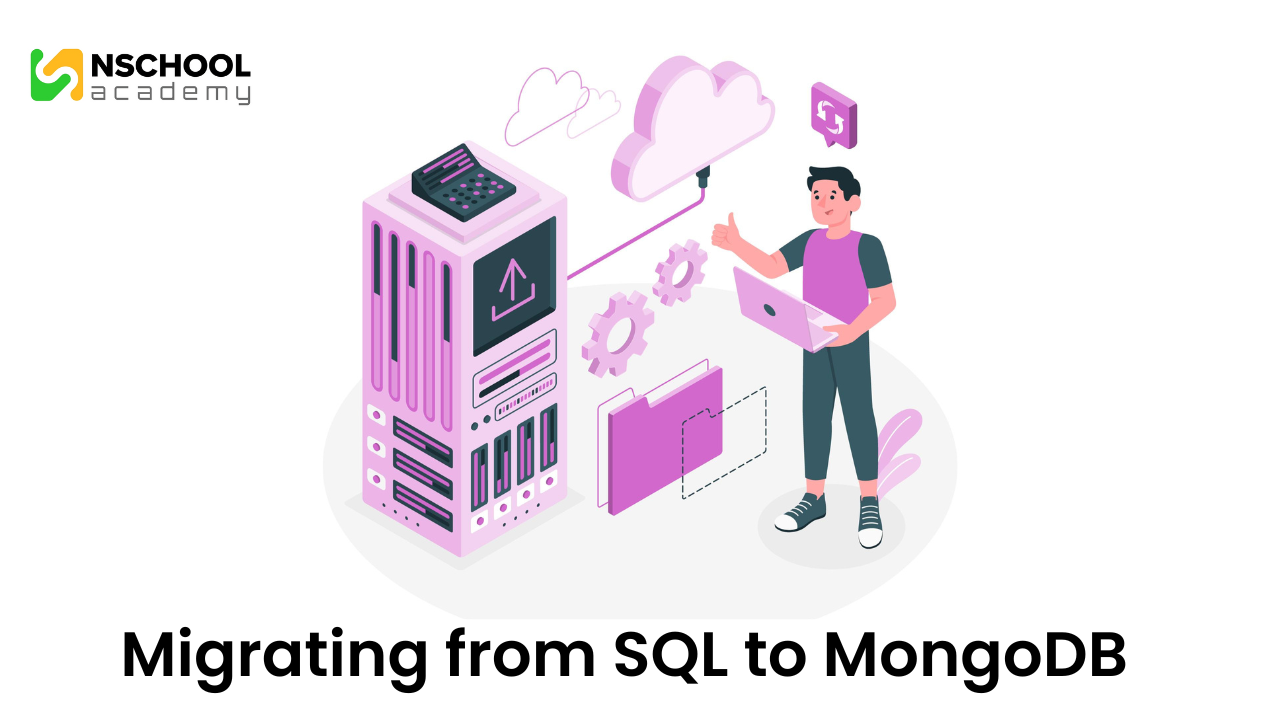Migrating from SQL to MongoDB
- January 23, 2025
- nschool
- 0

Introduction
In this blog you will see about Migrating from SQL to MongoDB. The technological landscape of databases is ever-evolving, and organizations constantly reevaluate their choices. One of the most significant shifts in the database world in recent years has been Migrating from SQL to MongoDB This transition is not merely about swapping one database for another; it’s about embracing a new paradigm that promises flexibility, scalability, and high performance.
Migrating from SQL to MongoDB
Before diving into the migration process, let’s understand why so many organizations are leaping. SQL databases, or relational databases, have been the gold standard for decades. However, with the rise of big data, unstructured data, and agile development, NoSQL databases like MongoDB have gained traction. Here are some compelling reasons to consider migrating from SQL to MongoDB:
- Schema Flexibility: Unlike SQL databases, MongoDB is schema-less. This means you can store data without defining its structure beforehand, which is invaluable for dynamic applications.
- Scalability: MongoDB’s horizontal scaling capabilities make it ideal for applications experiencing rapid growth.
- Performance: MongoDB’s design, which uses BSON (binary JSON), allows for faster data access and manipulation.
- Compatibility with Modern Development: MongoDB’s JSON-like document structure aligns well with modern application development frameworks and programming languages.
Challenges When Migrating from SQL to MongoDB
While the benefits of migrating from SQL to MongoDB are clear, the process comes with challenges. Here are some common hurdles:
- Data Modeling Differences: SQL’s tabular structure is fundamentally different from MongoDB’s document-based model. Adapting your data model requires careful planning.
- Query Language: Switching from SQL’s structured query language to MongoDB’s query syntax can take time to master.
- Application Code Changes: The migration often necessitates updates to the application’s codebase, especially if it heavily relies on SQL queries.
- Skillset Gap: Teams familiar with SQL need training to adapt to MongoDB’s nuances.
Steps for Migrating from SQL to MongoDB
A successful migration requires a structured approach. Below are the key steps involved in migrating from SQL to MongoDB:
1. Assess Your Current Environment
Before embarking on the migration journey, evaluate your existing SQL database. Identify the size of your data, its structure, and how it’s used. Understand the dependencies between your application and the database.
2. Define the MongoDB Data Model
One of the most critical steps in migrating from SQL to MongoDB is redefining your data model. While SQL uses tables, rows, and columns, MongoDB uses collections and documents. Here are some tips for designing an effective MongoDB schema:
Integrate related data into a single document whenever feasible.
- Use references when dealing with large, complex datasets.
- Avoid deeply nested documents as they can impact performance.
3. Select a Migration Tool
Numerous tools can help facilitate migrating from SQL to MongoDB. Some popular options include:
- MongoDB Atlas: Offers built-in migration tools.
- Studio 3T: Provides a user-friendly interface for data migration.
- Custom Scripts: Write scripts in languages like Python or JavaScript to handle unique migration requirements.
4. Export Data from SQL
Extract data from your SQL database in a format compatible with MongoDB. Common formats include CSV and JSON. Ensure data integrity during this step to prevent errors down the line.
5. Transform Data
Transforming data is essential to align it with MongoDB’s document-based structure. Leverage ETL processes to
- Flatten relational data.
- Map SQL tables to MongoDB collections.
- Convert data types as needed.
6. Import Data into MongoDB
Once transformed, import the data into MongoDB. Tools like mongoimport and MongoDB Compass simplify this process. Test the imported data to verify its accuracy and completeness.
7. Update the Application Code
After the data is in MongoDB, update your application to interact with the new database. Replace SQL queries with MongoDB’s query syntax. Leverage MongoDB drivers or libraries compatible with your programming language.
8. Test the Migration
Testing is a crucial step in migrating from SQL to MongoDB. Perform functional, performance, and regression testing to ensure the application works seamlessly with MongoDB. Validate data consistency and check for any anomalies.
9. Monitor and Optimize
Post-migration, monitor your MongoDB database to identify any performance bottlenecks. Optimize indexes, queries, and schema design as needed to achieve peak performance.
Best Practices for Migrating from SQL to MongoDB
Follow these best practices to ensure a seamless transition:
- Start Small: Begin with a pilot project or a subset of your data to minimize risks.
- Backup Data: Always maintain backups of your SQL database to safeguard against data loss.
- Document the Process: Keep detailed records of the migration steps to assist in troubleshooting and future migrations.
- Train Your Team: Provide training sessions to help your team become proficient in MongoDB.
- Use Staging Environments: Test the migration in a staging environment before going live.
Real-World Use Cases of Migrating from SQL to MongoDB
1. E-Commerce Platforms
E-commerce platforms often deal with diverse datasets, such as product catalogs, customer reviews, and order histories. Migrating from SQL to MongoDB allows these platforms to:
- Save complex data structures within a single document.
- Scale horizontally to handle traffic spikes.
- Deliver faster search and retrieval times.
2. Content Management Systems (CMS)
A CMS needs to manage a wide variety of content types and formats. MongoDB’s schema flexibility makes it an ideal choice for CMS platforms migrating from SQL.
3. IoT Applications
IoT systems generate massive volumes of unstructured data. Migrating from SQL to MongoDB enables these systems to:
- Handle high write and read throughput.
- Efficiently store time-series data.
- Scale to accommodate future growth.
Common Pitfalls When Migrating from SQL to MongoDB
Despite careful planning, some pitfalls can arise during the migration process:
- Underestimating Data Modeling: A poorly designed MongoDB schema can lead to performance issues.
- Skipping Testing: Inadequate testing can result in undetected errors in production.
- Neglecting Indexes: Failing to optimize indexes can slow down query performance.
- Overlooking Security: Ensure MongoDB is configured with appropriate security measures, such as authentication and encryption.
The Future of Database Technology
As organizations continue to prioritize scalability and agility, NoSQL databases like MongoDB are becoming more prominent. Migrating from SQL to MongoDB is not just a trend; it’s a strategic move to future-proof your database infrastructure. By understanding the nuances of this transition, you can harness the full potential of MongoDB and position your organization for long-term success.
Conclusion
Migrating from SQL to MongoDB is a transformative process that requires careful planning, execution, and testing. The benefits of this migration—including flexibility, scalability, and performance—make it a worthwhile endeavor for organizations looking to modernize their data infrastructure. By following best practices, leveraging the right tools, and addressing potential challenges, you can ensure a seamless migration journey. As you embark on this path, remember that the key to success lies in preparation, teamwork, and a commitment to continuous learning.

